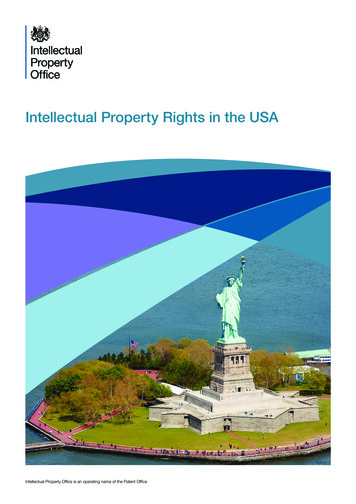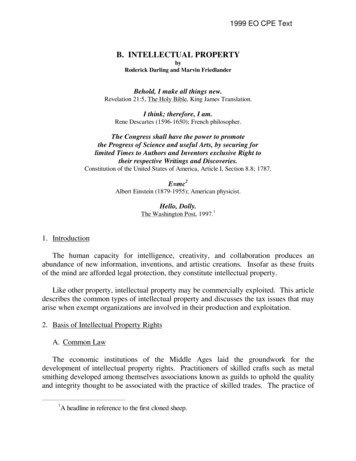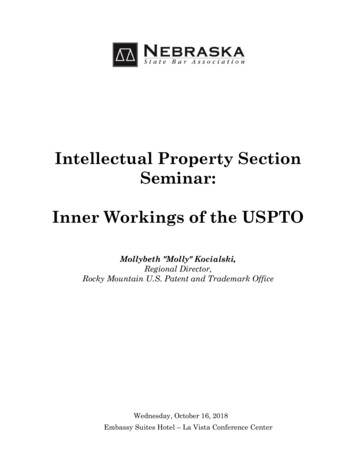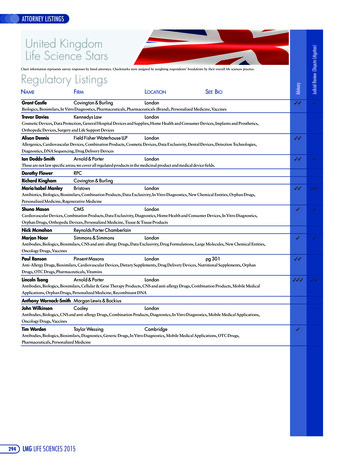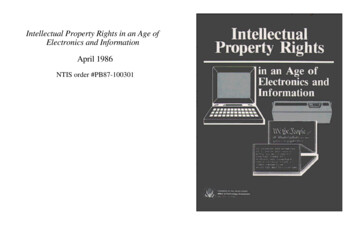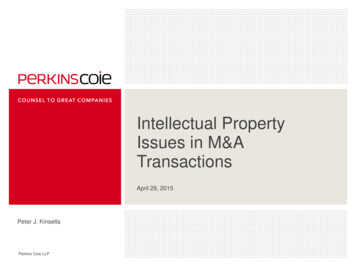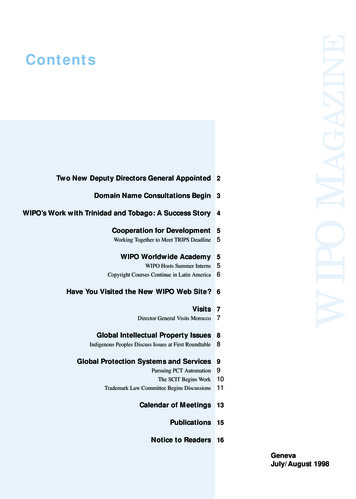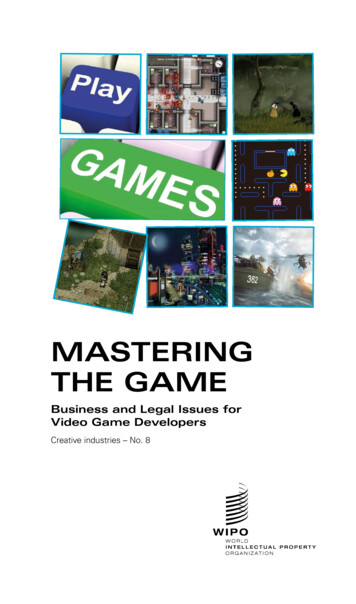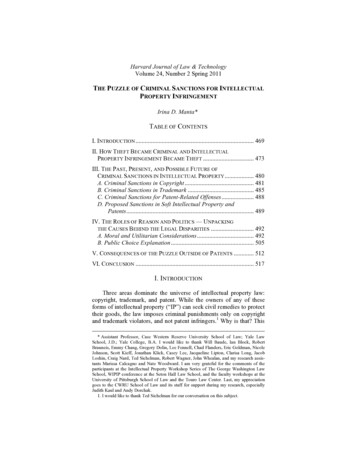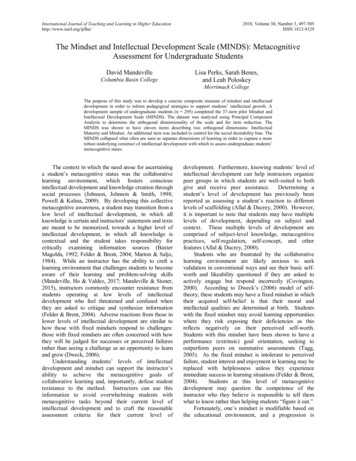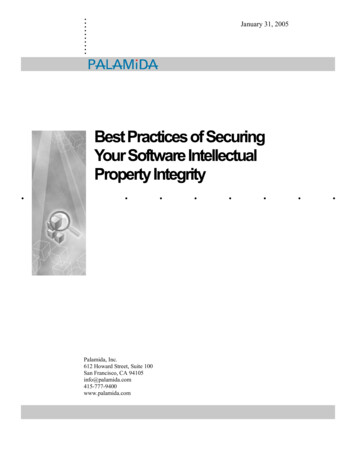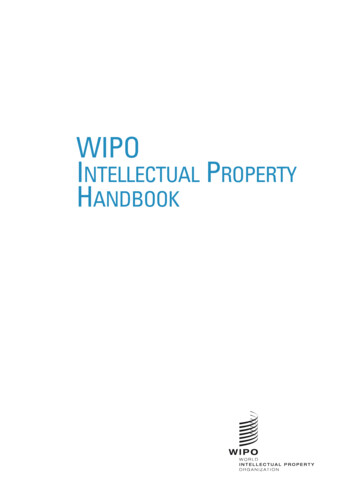
Transcription
WIPOINTELLECTUAL PROPERTYHANDBOOK
WIPO PUBLICATIONNo. 489 (E)ISBN 978-92-805-1291-5WIPO 2004Second EditionReprinted 2008
Detailed Table of ContentsChapter 1IntroductionThe Concept of Intellectual Property3The World Intellectual Property Organization (WIPO)4HistoryMission and utional ReformWider Consultation and Outreach45789912Chapter 2Fields of Intellectual Property ProtectionPatents17IntroductionConditions of PatentabilityDrafting and Filing a Patent ApplicationExamination of a Patent ApplicationInfringementExploitation of the Patented InventionCompulsory LicensesUtility Models1717222427333440
iiWIPO Intellectual Property Handbook: Policy, Law and UseCopyright and Related Rights40IntroductionCopyright ProtectionSubject Matter of Copyright ProtectionRights Comprised in CopyrightRelated RightsOwnership of CopyrightLimitations on Copyright ProtectionPiracy and InfringementRemediesIntellectual Property and Traditional Cultural ExpressionsTrends and Experiences in the Protection of TCEsConceptual and Policy QuestionsRecent and Possible Future IntroductionDefinitionsSigns Which May Serve as TrademarksCriteria of ProtectabilityProtection of Trademark RightsUse RequirementsTrademark RegistrationRemoval of the Trademark from the RegisterTrademark Piracy, Counterfeiting and Imitation of Labels and PackagingChange of OwnershipTrademark LicensingTrade NamesFranchisingCharacter al Designs and Integrated Circuits112Industrial DesignsIntegrated Circuits112118Geographical Indications120IntroductionProtection of Geographical Indications on the National LevelProtection of Geographical Indications on the International Level throughMultilateral TreatiesProtection of Geographical Indications on the International Level throughthe Provisions of Bilateral Agreements120122129Protection Against Unfair Competition130IntroductionThe Need for ProtectionThe Legal Basis for ProtectionThe Acts of Unfair Competition130132133136124
Table of contentsiiiChapter 3The Role of Intellectual Property in Development and WIPO’s DevelopmentCooperation ProgramObjectives of Developing Countries163Industrial Property and Development164Industrial Property Protection and DevelopmentInventions, Technology and Development164166The Promotion of Innovation168IntroductionA Global Approach to Establishing Innovation and Invention SupportStructures or ServicesImplementing and Managing Innovation and Invention SupportStructures and ServicesInnovation Center or Innovation Support Network168Licensing and the Transfer of Technology172IntroductionThe Commercial Transfer and Acquisition of TechnologyNegotiation of Licensing AgreementsRemunerationTypes of Intellectual Property LicensesGovernment Control of Licensing Agreements172172178184188193Copyright and Development195The Development Cooperation Program of WIPO196IntroductionObjectivesDevelopment Cooperation in Relation to Intellectual PropertyThe WIPO Worldwide Academy196196197202169170170Chapter 4Enforcement of Intellectual Property RightsEnforcement of Industrial Property Rights, Copyright andRelated Rights207IntroductionEnforcement of Industrial Property Rights in GeneralEnforcement of Patent RightsEnforcement of Copyright and Related RightsActivities Within WIPO Concerning EnforcementEnforcement Provisions of the TRIPS Agreement207208211213219220
ivWIPO Intellectual Property Handbook: Policy, Law and UseIntellectual Property Litigation220IntroductionReview of Industrial Property Office DecisionsInfringement ActionsRemedies220220225228Arbitration and Mediation of Intellectual Property Disputes230Alternative Dispute ResolutionEnforcement in the International ContextWIPO Arbitration and Mediation CenterWIPO Internet Domain Name Dispute Resolution230231232234Chapter 5International Treaties and Conventions on Intellectual PropertyThe Paris Convention for the Protection of Industrial Property241HistoryPrincipal ProvisionsAdministrative and Financial Provisions241242259The Berne Convention for the Protection of Literary andArtistic Works262HistoryPrincipal ProvisionsThe Latest (Paris) Act of the ConventionAdministrationDeveloping Countries and the Berne Convention262262265266267The WIPO Copyright Treaty (WCT)269IntroductionLegal Nature of the WCT and its Relationship with Other InternationalTreatiesSubstantive Provisions of the WCTAdministrative Provisions269269270276The Patent Cooperation Treaty (PCT)276IntroductionThe Functioning of the PCT SystemAdvantages of the PCT System276278282
vTable of contentsThe Budapest Treaty on the International Recognition of the Depositof Microorganisms for the Purposes of Patent Procedure285Background to the TreatySummary of the TreatyMain Advantages of the Treaty285285286The Madrid Agreement Concerning the International Registration ofMarks and the Protocol Relating to the Madrid Agreement287IntroductionThe Functioning of the System of International RegistrationBecoming Party to the Agreement or ProtocolAdvantages of the System287288292292The Hague Agreement Concerning the International Depositof Industrial Designs293IntroductionThe Principle of International DepositMain Provisions of the Hague AgreementBenefits of Accession to the Hague AgreementThe Geneva Act of the Hague Agreement293293293295296The Trademark Law Treaty (TLT)297IntroductionProvisions of the Treaty and the Regulations297297The Patent Law Treaty (PLT)301IntroductionProvisions of the Treaty and the RegulationsAdvantages of the PLT301301305Treaties on Classification305IntroductionThe Strasbourg Agreement Concerning the International PatentClassificationThe Nice Agreement Concerning the International Classification of Goodsand Services for the Purposes of the Registration of MarksThe Vienna Agreement Establishing an International Classification ofthe Figurative Elements of MarksThe Locarno Agreement Establishing an International Classificationfor Industrial Designs305305308311313Special Conventions in the Field of Related Rights: The InternationalConvention for the Protection of Performers, Producers of Phonogramsand Broadcasting Organizations (the “Rome Convention”)314IntroductionRelation Between the Protection of Related Rights and CopyrightPrincipal Provisions314315316
viWIPO Intellectual Property Handbook: Policy, Law and UseThe Implementation of the Rome ConventionThe Rome Convention and Developing Countries319319Other Special Conventions in the Field of Related Rights320The Other Special ConventionsReasons for and Purposes of the Special ConventionsMain Features of the Special ConventionsSubstantive Provisions of the Phonograms ConventionSubstantive Provisions of the Satellites ConventionThe Phonograms and Satellites Conventions and Developing Countries320321322323323324The WIPO Performance and Phonograms Treaty (WPPT)325IntroductionLegal Nature of the WPPT and its Relationship with Other InternationalTreatiesSubstantive Provisions of the WPPTAdministrative ProvisionsAudiovisual Performances325325326331331The International Convention for the Protection of New Varietiesof Plants331IntroductionThe International Union for the Protection of New Varieties of Plants(UPOV)The 1991 Act of the UPOV ConventionDevelopments in Plant Variety Protection331332335345The Agreement on Trade-Related Aspects of Intellectual Property Rights(“TRIPS”) and WIPO-WTO Cooperation345IntroductionGeneral Provisions, Basic Principles and Final Provisions (Parts I and VII)Standards Concerning the Availability, Scope and Use of IntellectualProperty Rights (Part II)Enforcement of Intellectual Property Rights (Part III)Acquisition and Maintenance of Intellectual Property Rights and RelatedProcedures (Part IV)Dispute Prevention and Settlement (Part V)Cooperation between the World Intellectual Property Organization and theWorld Trade Organization345347Progressive Development of International Intellectual Property Law360IntroductionThe Joint Recommendation Concerning Provisions for the Protection ofWell-Known MarksThe Joint Recommendation Concerning Trademark LicensesThe Joint Recommendation Concerning the Protection of Marks, and OtherIndustrial Property Rights in Signs, on the Internet360349355356357357361361362
Table of contentsviiChapter 6Administration and Teaching of Intellectual PropertyAdministration of Industrial Property367IntroductionAdministrative Structure in the Industrial Property OfficeThe Patent OfficeThe Trademark OfficeThe Industrial Designs OfficeIntergovernmental Cooperation367368369372375376Administration Of Copyright and Related Rights386The Role of Public Authorities in Copyright and Related RightsCollective Management of Copyright and Related Rights386387The Patent and Trademark Attorney401IntroductionThe Functions of a Patent AgentCorporate Patent AttorneysAssociations of Patent AgentsThe Functions of a Trademark AgentSkills and Knowledge of a Patent Agent401401411413415420The Teaching of Intellectual Property Law421IntroductionIntellectual Property Teaching ProgramsSelecting Intellectual Property CoursesChoosing Teaching Materials and Writing a SyllabusTeaching Methods and Educational StrategiesThe Role of Teachers in the Legislative ProcessTraining and Research Institutes for Intellectual PropertyConclusion421422425426428429430431Chapter 7Technological and Legal Developments in Intellectual PropertyComputer Programs435IntroductionBrief History of the Protection of Computer ProgramsProtection of Computer Programs under PatentsProtection of Computer Programs under CopyrightInternational Norms Concerning Copyright Protection of Computer ProgramsNational Legislation on the Protection of Computer ProgramsCreation and Use of Works by Means of ComputersDatabases435436436436437437439441
viiiWIPO Intellectual Property Handbook: Policy, Law and UseBiotechnology442IntroductionAdoption and DisseminationNeed for ProtectionExisting ProtectionTraditional Knowledge442443444445446Reprography448Reprography and Intellectual PropertyAudio and Video Recording448449Communication Technologies450IntroductionSatellitesCable DistributionDigital Distribution SystemsThe InternetElectronic Commerce450451453454455455A Complementary Approach to the Development of Intellectual PropertyNorms457WIPO Internet Domain Name ProcessesWIPO’s Global NetworkStanding Committees and Advisory BodiesBibliography457459459
Chapter 1INTRODUCTIONThe Concept of Intellectual PropertyThe World Intellectual Property Organization (WIPO)HistoryMission and utional ReformWider Consultation and Outreach
2WIPO Intellectual Property Handbook: Policy, Law and Use
Chapter 1 - Introduction3The Concept of Intellectual Property1.1Intellectual property, very broadly, means the legal rights which result from intellectualactivity in the industrial, scientific, literary and artistic fields. Countries have laws to protectintellectual property for two main reasons. One is to give statutory expression to the moral andeconomic rights of creators in their creations and the rights of the public in access to thosecreations. The second is to promote, as a deliberate act of Government policy, creativity and thedissemination and application of its results and to encourage fair trading which would contribute toeconomic and social development.1.2Generally speaking, intellectual property law aims at safeguarding creators and otherproducers of intellectual goods and services by granting them certain time-limited rights to controlthe use made of those productions. Those rights do not apply to the physical object in which thecreation may be embodied but instead to the intellectual creation as such. Intellectual property istraditionally divided into two branches, “industrial property” and “copyright.”1.3The Convention Establishing the World Intellectual Property Organization (WIPO), concludedin Stockholm on July 14, 1967 (Article 2(viii)) provides that “intellectual property shall include rightsrelating to:-literary, artistic and scientific works,performances of performing artists, phonograms and broadcasts,inventions in all fields of human endeavor,scientific discoveries,industrial designs,trademarks, service marks and commercial names and designations,protection against unfair competition,and all other rights resulting from intellectual activity in the industrial, scientific, literary or artisticfields.”1.4The areas mentioned as literary, artistic and scientific works belong to the copyright branchof intellectual property. The areas mentioned as performances of performing artists, phonogramsand broadcasts are usually called “related rights,” that is, rights related to copyright. The areasmentioned as inventions, industrial designs, trademarks, service marks and commercial names anddesignations constitute the industrial property branch of intellectual property. The area mentionedas protection against unfair competition may also be considered as belonging to that branch, themore so as Article 1(2) of the Paris Convention for the Protection of Industrial Property (StockholmAct of 1967) (the “Paris Convention”) includes “the repression of unfair competition” among theareas of “the protection of industrial property”; the said Convention states that “any act ofcompetition contrary to honest practices in industrial and commercial matters constitutesan act of unfair competition” (Article 10bis(2)).1.5The expression “industrial property” covers inventions and industrial designs. Simply stated,inventions are new solutions to technical problems and industrial designs are aesthetic creationsdetermining the appearance of industrial products. In addition, industrial property includestrademarks, service marks, commercial names and designations, including indications of source andappellations of origin, and protection against unfair competition. Here, the aspect of intellectualcreations—although existent—is less prominent, but what counts here is that the object of
4WIPO Intellectual Property Handbook: Policy, Law and Useindustrial property typically consists of signs transmitting information to consumers, in particular asregards products and services offered on the market, and that the protection is directed againstunauthorized use of such signs which is likely to mislead consumers, and misleading practices ingeneral.1.6Scientific discoveries, the remaining area mentioned in the WIPO Convention, are not thesame as inventions. The Geneva Treaty on the International Recording of Scientific Discoveries(1978) defines a scientific discovery as “the recognition of phenomena, properties or laws of thematerial universe not hitherto recognized and capable of verification” (Article 1(1)(i)). Inventions arenew solutions to specific technical problems. Such solutions must, naturally, rely on the propertiesor laws of the material universe (otherwise they could not be materially or “technically” applied),but those properties or laws need not be properties or laws “not hitherto recognized.” Aninvention puts to new use, to new technical use, the said properties or laws, whether they arerecognized (“discovered”) simultaneously with the making of the invention or whether they werealready recognized (“discovered”) before, and independently of, the invention.The World Intellectual Property Organization (WIPO)History1.7The World Intellectual Property Organization (WIPO) is one of the specialized agencies of theUnited Nations (UN) system of organizations. The “Convention Establishing the World IntellectualProperty Organization” was signed at Stockholm in 1967 and entered into force in 1970. However,the origins of WIPO go back to 1883 and 1886, with the adoption of the Paris Convention and theBerne Convention respectively. Both of these conventions provided for the establishment ofinternational secretariats, and both were placed under the supervision of the Swiss FederalGovernment. The few officials who were needed to carry out the administration of the twoconventions were located in Berne, Switzerland.1.8Initially there were two secretariats (one for industrial property, one for copyright) for theadministration of the two conventions, but in 1893 the two secretariats united. The most recentname of the organization, before it became WIPO, was BIRPI, the acronym of the French-languageversion of the name: United International Bureaux for the Protection of Intellectual Property (inEnglish). In 1960, BIRPI moved from Berne to Geneva.1.9At the 1967 diplomatic conference in Stockholm, when WIPO was established, theadministrative and final clauses of all the then existing multilateral treaties administered by BIRPIwere revised. They had to be revised because member States wished to assume the position of fullgoverning body of the Organization (WIPO), thus removing the supervisory authority of the SwissGovernment, to give WIPO the same status as all the other comparable intergovernmentalorganizations and to pave the way for it to become a specialized agency of the United Nationssystem of organizations.1.10 Most of the intergovernmental organizations now called specialized agencies did not existbefore the Second World War. They were created for the specific purpose of dealing with aparticular subject or field of activity at the international level. However, some intergovernmentalorganizations, such as the International Labor Office (ILO), the Universal Postal Union (UPU) and theInternational Telecommunication Union (ITU) were in existence, and had become the responsibleintergovernmental organizations in their respective fields of activity long before the establishment of
Chapter 1 - Introduction5the United Nations. After the United Nations was established, these organizations becamespecialized agencies of the United Nations system.1.11 Similarly, long before the United Nations was established, BIRPI was the responsibleintergovernmental organization in the field of intellectual property. WIPO, the successor to BIRPI,became a specialized agency of the United Nations when an agreement was signed to that endbetween the United Nations and WIPO which came into effect on December 17, 1974.1.12 A specialized agency, although it belongs to the family of United Nations organizations,retains its independence. Each specialized agency has its own membership. All member States ofthe United Nations are entitled to become members of all the specialized agencies, but in fact notall member States of the United Nations are members of all the specialized agencies. Each Statedecides for itself whether it wants, or does not want, to become a member of any particularspecialized agency. Each specialized agency has its own constitution, its own governing bodies, itsown elected executive head, its own income, its own budget, its own staff, its own programs andactivities. Machinery exists for coordinating the activities of all the specialized agencies, amongthemselves and with the United Nations, but basically each agency remains responsible, under itsown constitution, to its own governing bodies, which are the States members of the organization.1.13 The agreement between the United Nations and WIPO recognizes that WIPO is, subject tothe competence of the United Nations and its organs, responsible for taking appropriate action inaccordance with its basic instrument and the treaties and agreements administered by it, inter alia,for promoting creative intellectual activity and for facilitating the transfer of technology related toindustrial property to developing countries in order to accelerate economic, social and culturaldevelopment.Mission and Activities1.14 The mission of WIPO is to promote through international cooperation the creation,dissemination, use and protection of works of the human mind for the economic, cultural and socialprogress of all mankind. Its effect is to contribute to a balance between the stimulation of creativityworldwide, by sufficiently protecting the moral and material interests of creators on the one hand,and providing access to the socio-economic and cultural benefits of such creativity worldwide onthe other.1.15 WIPO’s place on the international scene has greatly changed since its beginnings, when itwas created to serve as the secretariat of treaties concluded between States. Although WIPO hasmaintained this function (it currently administers 23 such treaties), together with the consequentialone of promoting intergovernmental cooperation in the administration of intellectual property, itsactivities have not only expanded, but also greatly diversified.1.16 An outstanding example of the expansion of WIPO’s earlier work is the growth of itsregistration activities—that is to say, the increase in the use of international treaties that create thefacility of a single procedure to apply for patents and register trademarks and industrial designs,valid in up to all States party to those treaties. The Patent Cooperation Treaty (PCT), the MadridAgreement and Protocol Concerning the International Registration of Marks, and the HagueAgreement Concerning the International Deposit of Industrial Designs have all given rise to anincreased volume of registration activities. To strengthen this aspect of WIPO’s work, a newinternational treaty, namely, the Patent Law Treaty, came into existence in June 2000: its purpose is
6WIPO Intellectual Property Handbook: Policy, Law and Useto streamline application procedures and to reduce the cost of obtaining simultaneous patentprotection in several countries.1.17 In its more recent history, WIPO increasingly does not stop short of promoting all kinds ofintellectual property. This is only the means to achieve an end, which is to promote humancreativity that results in industrial and cultural products and services enriching human society as awhole. Thus WIPO is increasingly involved in helping developing countries, whose creativity has yetto be adequately harnessed, to receive the full benefits of the creations of their citizens, as well asthose of the outside world. WIPO’s role is to assist them also in the preparation and enforcementof laws, in the establishment of sound institutions and administrative structures and in the trainingof appropriate personnel. WIPO has given particular attention to the 49 Least Developed Countries(LDCs), as will be seen in chapter 3, and has also given similar assistance to countries whoseeconomies are in transition, in Central Asia, Central and Eastern Europe and the Baltic region.1.18 WIPO’s cooperation for development program is closely interwoven with governmental andintergovernmental cooperation, including WIPO’s agreement with the World Trade Organization(WTO), whereby WIPO assists developing countries in the implementation of WTO’s Agreement onTrade-Related Aspects of Intellectual Property Rights (TRIPS) (see chapter 5).1.19 The problem of development is compounded by rapid technological and scientific progress.WIPO’s approach is twofold: it is to identify and to promote international solutions to the legal andadministrative problems posed by digital technology, especially the Internet, to the traditionalnotions and practices of intellectual property.1.20 WIPO’s work in alternative dispute resolution between individuals and companies, throughthe WIPO Arbitration and Mediation Center (see chapter 4) has been extended to cover theproblems arising from the misuse of domain names on the Internet. WIPO has been accredited bythe Internet Corporation for Assigned Names and Numbers (ICANN) to administer cases filed underICANN’s Uniform Domain Name Dispute Resolution Policy. Disputes are handled and resolvedonline, enabling parties to settle cases in a time- and cost-effective manner, without being physicallypresent in the same place.1.21 A project that will greatly advance the sharing of valuable intellectual property informationbenefits is the worldwide global intellectual property information network (WIPONET), a projectlaunched by WIPO in 1999. WIPONET is designed to establish a secure, global network linking theintellectual property offices of all WIPO’s Member States, facilitating access to and exchange ofinformation worldwide. Already WIPO’s main and subsidiary websites are heavily used all over theworld.1.22 WIPO is increasingly adopting a global approach not only to intellectual property in itself,but to the place of intellectual property in the wider framework of emerging issues such astraditional knowledge, folklore, biological diversity, environmental protection and human rights.These issues are explored in chapter 2 and chapter 7. WIPO has followed the method ofconsultation and empirical research to find, for example, the relation between intellectual propertyand genetic resources, traditional knowledge and folklore.1.23 One of the most significant present-day tasks of WIPO is to demystify intellectual property,so that it is recognized as a part of everyday life not only by those directly involved in it atgovernmental, legal, industrial and cultural levels, but also by any others who compose civil society,whether in non-governmental organizations or small businesses, whether farmers, public healthpersonnel, individual creators or simply interested members of the general public. Realizing theimportance of small- and medium-sized enterprises (SMEs) as the backbone of market economies,
Chapter 1 - Introduction7WIPO has established a program aimed at helping them to fulfill their potential as a powerful forcebehind wealth creation.1.24 WIPO’s agenda of outreach to all members of society is through their inclusion asstakeholders and partners in global and national intellectual property systems. To ensure that suchinclusion is of benefit to the parties concerned, WIPO pursues a policy of empowerment. Thismeans that WIPO’s activities aim to give to all levels of society an awareness of how they have astake in a healthy intellectual property system, and also to provide them with access to theknowledge, experience and expertise that will enable them to use those systems effectively.Structure1.25 The constitution, the “basic instrument,” of WIPO is the Convention signed at Stockholm in1967. In describing WIPO, the following questions will be answered in very general terms: why isan intergovernmental organization needed? What are the Unions administered by WIPO? WhichStates are members of WIPO? What does WIPO do? How is it governed and managed?1.26 The General Assembly consists of all the States that are members of WIPO and alsomembers of any of the Unions.1.27 Unlike the General Assembly, the Conference consists of all the States which are membersof WIPO, whether or not they are members of any of the Unions. The main functions of theConference were originally divided into five groups. First, the Conference was to constitute a forumfor exchanges of views between all States members of WIPO on matters relating to intellectualproperty, and in that context it was empowered, in particular, to make any recommendations onsuch matters, having regard to the competence and autonomy of the Unions. Secondly, theConference was to establish the biennial development cooperation program for developingcountries and, thirdly, it was to adopt a budget for that purpose. Fourthly, the Conference is alsocompetent to adopt amendments to the Convention establishing WIPO. Proposals for theamendment of the Convention may be initiated by any State member of WIPO, by the CoordinationCommittee or by the Director General. Fifthly, the Conference, like the General Assembly, was todetermine which States and organizations would be admitted to its meetings as observers.1.28 Why is an intergovernmental intellectual property organization needed? Intellectualproperty rights are limited territorially; they exist and can be exercised only within the jurisdiction ofthe country or countries under whose laws they are granted. But works of the mind, includinginventive ideas, do and should cross frontiers with ease in a world of interdependent nations.Moreover, with growing similarity in the approach and procedures governing intellectual propertymatters in various countries, it makes eminent sense to simplify practice through internationalstandardization and mutual recognition of rights and duties among nations.Therefore,governments have negotiated and adopted multilateral treaties in the various fields of intellectualproperty, each of which establishes a “Union” of countries which agree to grant to nationals ofother countries of the Union the same protection as they grant to their own, as well as to followcertain common rules, standards and practices.1.29 The Unions administered by WIPO are founded on the treaties. A Union consists of all theStates that are party to a particular treaty. The name of the Union is, in most cases, taken from theplace where the text of the treaty was first adopted (thus the Paris Union, the Berne Union, etc.).The treaties fall into three groups.
8WIPO Intellectual Property Handbook: Policy, Law and Use1.30 The first group of treaties establishes international protection, that is to say, they are treatieswhich are the source of legal protection agreed between countries at the international level. Forinstance, three treaties on industrial property fall into this group—the Paris Convention, the MadridAgreement for the Repression of False and Deceptive Indications of Source on Goods and theLisbon Agreement for the Protection of Appellations of Origin and their International Registration.1.31 The second group consists of treaties which facilitate international protection. For instance,six treaties on industrial property fall into this group. They are the Patent Cooperation Treaty, whichprovides for the filing of international applications for patents, the Madrid Agreement Concerningthe International Registration of Marks, the Lisbon Agreement,
WIPO PUBLICATION No. 489 (E) ISBN 978-92-805-1291-5
